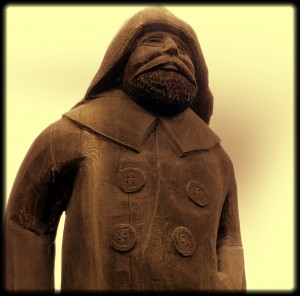
Noyo Harbor in Fort Bragg is one of four California harbors north of San Francisco. Noyo Harbor’s primary commercial fisheries include:
- Groundfish : trawl
- Urchin: dive
- Chinook salmon: troll
- Dungeness crab: trap/pot
- Sablefish and rockfish/lingcod: hook-and-line and trap
Although most resident fishermen participate in more than one fishery, locals describe the roughly 80-vessel fleet as including 30–40 salmon trollers, 15–20 multi-fishery vessels, 10–15 urchin dive boats and 7 groundfish trawlers.
Salmon: Robust annual salmon migrations have long been a sign of a healthy Pacific ecosystem. However, recent crashes in the salmon populations have highlighted our lack of understanding of these complex species. Our salmon fisheries are managed by the Pacific Fishery Management Council and enforced by the state Department of Fish and Wildlife. Management tools such as season length, quotas, and bag limits vary depending on how many salmon are present in a given year.
The salmon troll fishery is among Noyo Harbor’s top three fisheries, although the number of boats participating in this fishery has declined in recent years due to the salmon collapse. Experts are uncertain about what has caused the collapse, pointing to dozens of factors including unusual weather patterns, silt from logging and coastal development, poor habitat and water quality, unfavorable ocean conditions and water diversions. Estimating the effects of changes in ocean conditions and weather on salmon are particularly difficult, but new research into the relationship between ocean environmental factors and salmon abundance show some promise.

Crab: The crab fishery is one of the oldest commercial fisheries in California, starting in the 1880’s in SF Bay around the time of the Gold Rush. Over the past 10 years, the ex-vessel value of this fishery average over $30 million statewide, making it one of the most valuable fisheries in the California. Although the crab fishery is very big in northern California, activity in Noyo Harbor is modest compared to other ports, in part due to the fact that several local fishermen target grounds nearer other ports, where crab are more abundant, and where they deliver most of their catch.
The crab fishery has been regulated by the state legislature since 1897, when the first statue was passed prohibiting the take and sale of females. The Mendocino-Sonoma county line demarcates the central and northern management areas; two distinct regions with different seasons. In 2011, the state legislature established the Dungeness Crab Task Force, made up of commercial and recreational fisherman. Through the task force, fishermen participate directly in the management of this fishery, providing recommendations on, among other things, pot limits, harvest allocation, fishing effort, and season modifications.
Groundfish:
For a better understanding of the management context of our fisheries, go the Sea Grant California Fisheries webpage.
The History of Noyo Harbor:
adapted from Sea Grant’s Noyo Harbor Fishing Communities Profile

